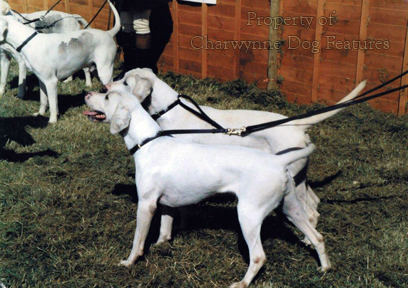796 Recognizing the Harrier
Recognizing The Harrier
by David Hancock
 Lack of Recognition
Lack of Recognition
The Foxhound, the Beagle and the Basset Hound are recognized as breeds by the Kennel Club but not at the moment the Harrier. This has not always been the case. Four were registered with the KC in 1913 and 20 in 1925. At the Armagh Dog Show in 1892 the Harrier judge reported in The Kennel Gazette in December of that year that: "Harriers had six couples, all from the same kennel. They were a very even lot..." The KC does however recognize hare-hounds from abroad as the Hamiltonstovare, the Basset Fauve de Bretagne, the Segugio Italiano and the two Basset Griffon Vendeen breeds demonstrate. The American Kennel Club does recognize our Harrier, to me a sad reflection on our custody of native breeds. But the fortunes of the Harrier have always varied. If you take for example the chronology of hare-hunting in just Surrey and Sussex from 1738 to 1925, it shows that 24 packs of Harriers either disbanded, merged or changed to another breed in that period, a period when hunting was an obsession rather than a pastime. This rate of change has rarely been matched in other breeds of packhounds. 
In his The Dogs of the British Islands of 1878, Stonehenge alias JH Walsh, wrote on this breed that: "In the present day it is very difficult to meet with a harrier possessed of blood entirely unmixed with that of the foxhound...Breeders still take special care to have a combination of intelligence and high scenting power sufficient to meet the wiles of the hare, which are much more varied than those of the fox..." He also referred to a Rough Welsh Harrier stating that it "still exists in a state of comparative purity"; another native breed neglected to the point of extinction.
In his The Illustrated Book of the Dog of 1879, Vero Shaw writes on the breed: "It is as a dwarf Southern Hound that the Harrier should be most properly regarded...One peculiarity, however, which distinguishes a Harrier from a Foxhound is the recognition of blue-mottle as a correct colour for the breed". For hare-hunting however, the esteemed Beckford, regarded as the authority on packhounds in the late 18th century and early 19th century, favoured a cross "between the large, slow-hunting Harrier and the little Fox Beagle". Rawdon Lee, in his Modern Dogs, Sporting Division: Vol I of 1897, wrote that: "Unless some very considerable change takes place, it is extremely likely that the harrier will not survive very many generations, at any rate in this country." He referred to a smooth-coated Welsh Harrier, black or black and tan in colour, and, separately to a range of shoulder height in the breed from 15½ to 22 inches.
Struggle for Identity
Against that background, it is easy to see why this breed has struggled to maintain its identity over two centuries yet emerged with distinction. In his Hounds of 1913, Frank Townend Barton writes on Harriers that "there are about eighty-five packs in England and Wales, forty packs in Ireland, but only one in Scotland...one of the oldest packs of Harriers is the Pennistone...consisting of thirteen couples of 22 to 24 inch pure Harriers, or hounds of the English type". He stated that the Holcombe Harriers, 200 years old, was composed of twenty couples of 22 inch 'Old English Harriers'. I believe there are just over a dozen packs of Harrier still in existence, and, whilst a big reduction from the 85 of a century ago, the breed has survived rather better than Rawdon Lee's gloomy prediction. 
But if the breed is to be recognized as such away from the hunting field, what should it look like? Should it resemble the Southern Hound with ears like the Sabueso Espanol and the Swiss Laufhund breeds? Should it be black and tan like the Welsh Harrier of old and the Schillerstovare, the Slovene Mountain Hound and the Kerry Beagles of the Scarteen pack? Should it be blue-mottled like the Hailsham Harriers or lemon and mainly white like the Istrian Hound and our own West Country Harrier? The Old English Harrier was cloddier than say our Studbook Harrier of today; but is that the right template? Is the Harrier a 16 inch high hound or one standing at 22 inches? In the USA they are expected to be 19-21 inches (doghound) at shows.
The Official Standard for the breed of Harrier set out by the American KC states: "They must be active, well balanced, full of strength and quality, in all ways appearing to be able to work tirelessly, no matter the terrain, for long periods. Running gear and scenting ability are particularly important features." That's not a bad start! Those worthies favouring the hound of the packs care less about uniformity and Breed Standards than the show ring devotees but if the Harrier is to survive in the long term, will it need, like the Otterhound, a show ring presence? Retaining type might be a problem and 'showiness' could become dominant, but isn't the survival of the breed and its blood more important in the very long term?
(David Hancock's latest book Hounds - Hunting by Scent is being published by Crowood in 2014)